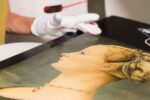Tom Tom Roma
.jpg)
Maps and boundaries from Insolera to the street art – Lecture di Stefano Ciavatta.
Comunicato stampa
TOM TOM ROMA
Maps and boundaries of modern Rome from Insolera to the street-art.
Friday the 18th of March 2016 - 7.00 p.m.
Lecture by Stefano Ciavatta
at
CAMPO
via della Marrana 94
00181 Roma
www.campo.space
*versione italiana in basso*
As we know all roads lead to Rome. Yet, since Rome became capital in 1870 the boundaries of the city moved over and over again. Where does Rome ends? Where does the capital begins?
Any map of Rome has much more to tell than the covered area, since it has to hold a territory that, in respect to the ancient Aurelian Walls, is limitless. Exploded in a delirious archipelago of distant places, more and more difficult to bind together, Rome is an interrupted discourse of fragments that have only one thing in common: it’s always Rome.
Through fifteen maps of Rome, coupled with images from movies, archives and reportages, Stefano Ciavatta will try to tell the story of how the gates, the checkpoints, the Hercules Columns that give access to the “continent Rome” have changed. An extra-ordinary narrative that will mix the Nolli and the Monaldini plans with the Touring Club Guides of the Fascist period; the Pincio’s terrace of Remo Remotti and the Tangenziale of Maurizio Merli; Clint Eastwood’s horse in Cinecittà and Nanni Moretti’s fencing wall in Spinaceto; the GRA of Rosi, the Palacavicchi palm trees, the Dubai Palace on the Tiburtina road, Zerocalcare’s Mammoth, the new street art scene and the metropolitan area of Rome in 20-25.
Stefano Ciavatta is a journalist and press officer. He lives and work in Rome, two things that take a lot of time.
*
TOM TOM ROMA
Mappe e confini di Roma moderna da Insolera alla street-art
Venerdì 18 Marzo 2016 - h. 19.00
Lezione di Stefano Ciavatta
a
CAMPO
via della Marrana 94
00181 Roma
www.campo.space
Si sa che tutte le strade portano a Roma ma i confini della città dal 1870 in poi si sono spostati più volte. Dove finisce Roma? Dove inizia la capitale? Qualsiasi mappa di Roma racconta molto di più delle distanze comprese perché deve tenere a bada un territorio smisurato rispetto alle antiche Mura Aureliane, esploso in un arcipelago delirante di luoghi distanti che si fatica a tenere insieme, come se Roma fosse un discorso interrotto, e che invece hanno un unico comune denominatore: è sempre Roma.
Attraverso quindici cartine di Roma e altrettante immagini prese da film, archivi e reportage proveremo a raccontare come sono cambiate le porte d’accesso al continente Roma, quelle che nel corso del tempo sono state considerate le colonne d’Ercole e i nuovi checkpoint, mescolando le mappa del Nolli e del Monaldini con le guide Touring del Ventennio, il cartello di Centocelle bottino di guerra, il balcone del Pincio di Remotti e la Tangenziale di Maurizio Merli, il cavallo di Eastwood a Cinecittà e il muretto di Spinaceto di Nanni Moretti, il Raccordo Anulare di Rosi, le Palme del Palacavicchi, Dubai Palace sulla Tiburtina, il Mammuth di Zerocalcare, la nuova mappa della street art e l’area metropolitana di Roma 20-25.
Stefano Ciavatta. Giornalista e ufficio stampa. Vive e lavora a Roma, entrambe le cose portano via molto tempo.
CAMPO is a space to debate, study and celebrate architecture, born in Rome out of the collaboration between Gianfranco Bombaci, Matteo Costanzo, Luca Galofaro e Davide Sacconi.
CAMPO invites researchers, professionals and students to expose projects, experiments and researches that challenge the current understanding of the city, and to collaborate in the investigation of the potential and the limits of architecture as a form of collective production and common knowledge.



